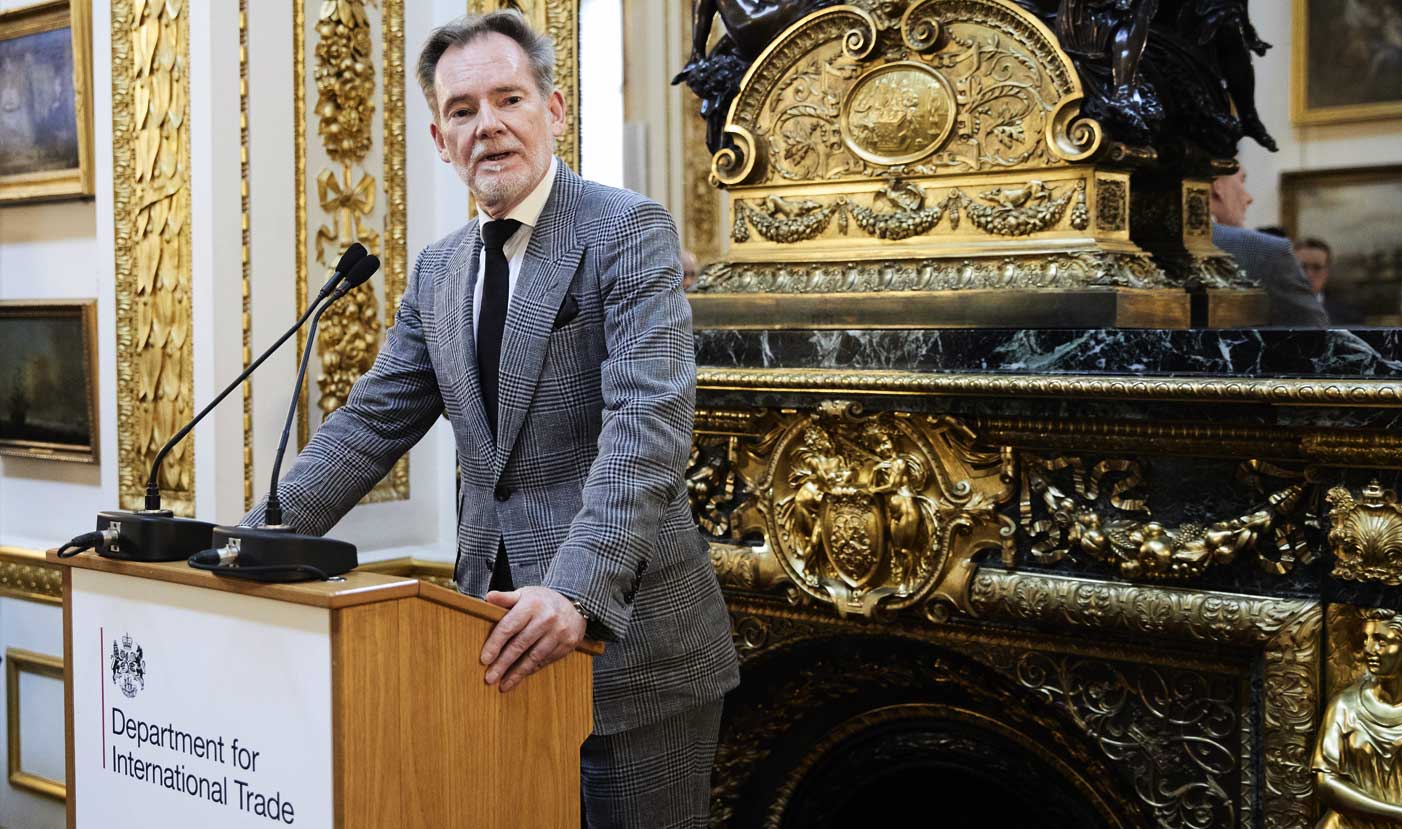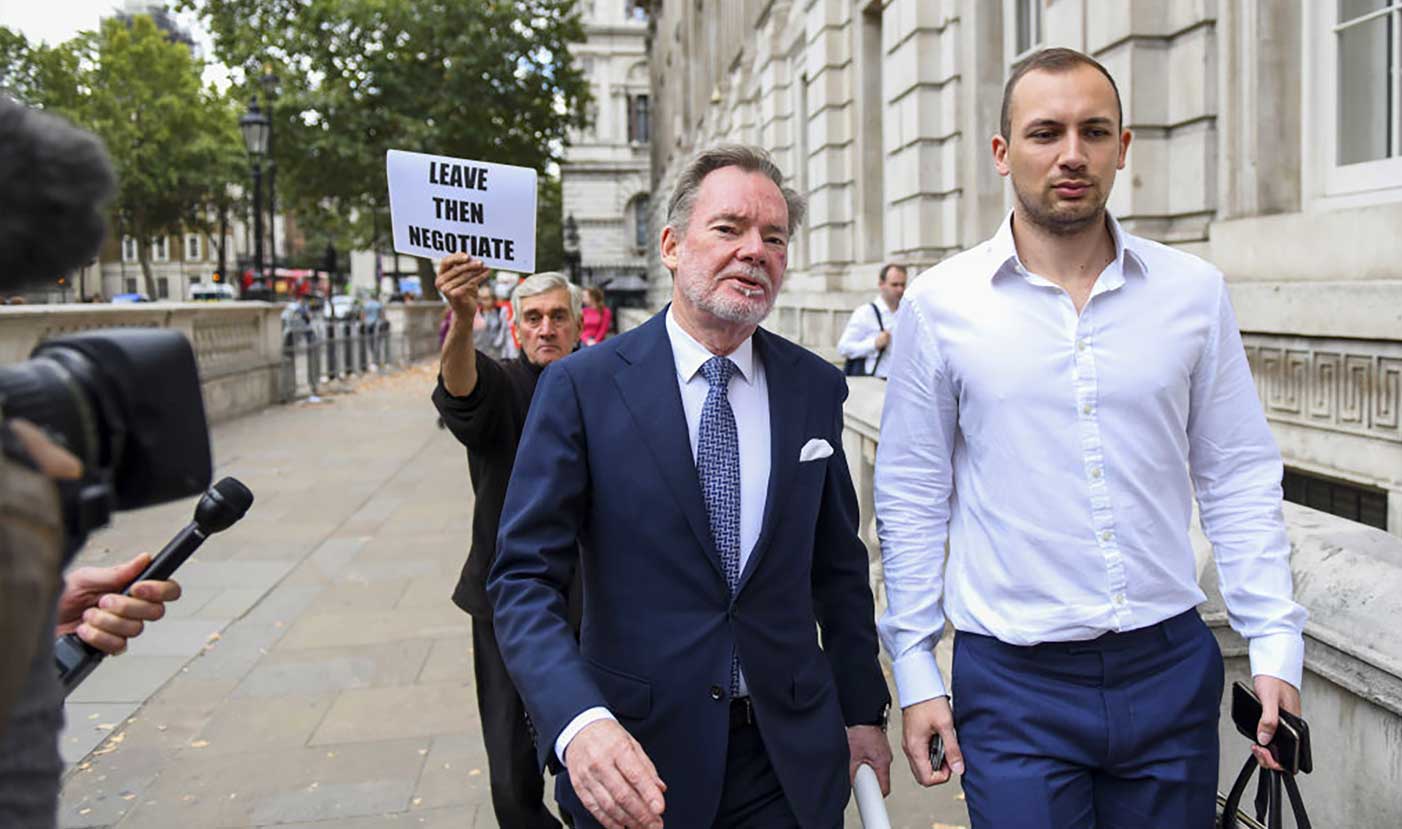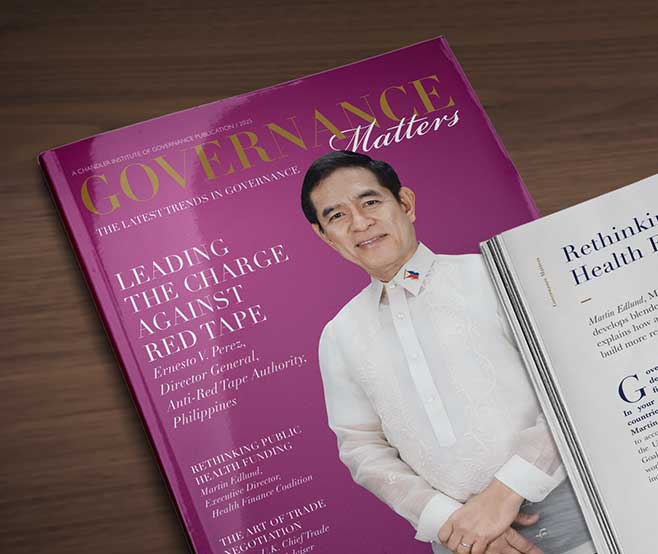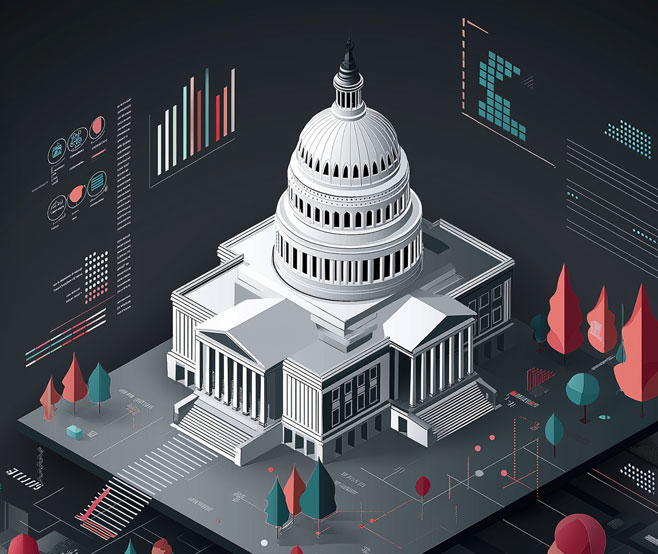The Art of Trade Negotiation
After spending more than 30 years at the sharp end of international trade negotiations, Sir Crawford Falconer is one of the world’s most experienced and respected voices in the field. In a wide-ranging interview with Governance Matters, Falconer discusses the qualities that effective negotiators share, the “bear traps” they should avoid, and the lessons he drew from helping to scale the U.K.’s trade negotiation team from scratch.
Lorem ipsum dolor sit amet, consectetur adipiscing elit, sed do eiusmod tempor incididunt ut labore et dolore magna aliqua. Ut enim ad minim veniam, quis nostrud exercitation ullamco laboris nisi ut aliquip ex ea commodo consequat. Duis aute irure dolor in reprehenderit in voluptate velit esse cillum dolore eu fugiat nulla pariatur.
Heading 1
Heading 2
Heading 3
Heading 4
Heading 5
Heading 6
Lorem ipsum dolor sit amet, consectetur adipiscing elit, sed do eiusmod tempor incididunt ut labore et dolore magna aliqua. Ut enim ad minim veniam, quis nostrud exercitation ullamco laboris nisi ut aliquip ex ea commodo consequat. Duis aute irure dolor in reprehenderit in voluptate velit esse cillum dolore eu fugiat nulla pariatur.
Block quote
Heading 6
Ordered list
- Item 1
- Item 2
- Item 3
Unordered list
- Item A
- Item B
- Item C
Bold text
Emphasis
Superscript
Subscript
When he was appointed the United Kingdom’s Chief Trade Negotiation Adviser in 2017, Sir Crawford Falconer was handed the fiercely complex task of helping to design and lead the U.K.’s trade negotiation system ahead of its departure from the European Union (EU). The country had not negotiated its own trade agreements for decades, and there was no ready-made team of negotiators or institutional playbook to draw on. Falconer was responsible for architecting an entirely new trading policy and building that negotiation capacity almost from scratch. He drew on more than 30 years of experience, including as
New Zealand’s Chief Trade Negotiator, Deputy Secretary in its Ministry of Foreign Affairs and Trade, and its Ambassador to the World Trade Organisation (WTO), to build that capacity and steer the U.K.’s early post-Brexit trade strategy. During his tenure, he helped deliver landmark agreements with Australia and New Zealand, and led the U.K.’s accession to the Comprehensive and Progressive Agreement for Trans-Pacific Partnership (CPTPP). Having stepped down from his U.K. role in 2024, Falconer reflected on what he has learned from a career spent navigating the politics, detail, and dynamics of international trade.
Governance Matters: You’ve led trade negotiations in different national and international settings, and during periods when the priorities and politics of trade looked different from today. In your experience, are there universal traits or behaviours that successful trade negotiators tend to share?
Sir Crawford Falconer: The short answer is yes.
The first thing is to be a very good listener and to genuinely hear what people are saying. A lot of it is flannel, but that is how you are going to understand what motivates the other side. You have to be a researcher. You have to do your homework, depending on where you are in the negotiation process.
And you have to be a leader. You need to be able to motivate your own team, which means you have to give them responsibility and allow them to exercise it. You have to be able to give them a picture of what you are trying to achieve, what their priorities are, why what they are doing is important, and how that fits into the overall scheme of things. Sometimes, you also have to manage the other side, who may not be able to organise themselves, and carefully help them in some situations.
These qualities, in my view, are not unique to trade negotiations. They are the same skills you need for managing any group of people, or for many areas of government policy.
In trade, because you are dealing directly with another sovereign government, some diplomatic skills are more needed than in other government situations. When you deal with other departments or attend interdepartmental meetings, you are going through a process of consensus building. That is how you reach an outcome.
You also need to apply those skills to dealing with another sovereign government that does not share the consensus-based approach you experience working inside government departments. And they will probably have more diverse objectives. They are the same kind of techniques you have to apply in order to get to an outcome.
And as with any outcome, it is not about winners and losers. It is about how you construct something that works for them in a way that enables them to give you what you really need.
So, to me, these are not only trade negotiator skills. I often found, though you cannot overgeneralise, people with foreign language skills seem to perform quite well. People who have ingrained in them the ability to listen to nuance can have a distinct advantage.

What are the common “bear traps” for trade negotiators to avoid when they enter into a negotiation? What makes a negotiation successful?
Some of them are basic things: Do not always act as if you are the demandeur. People have this psychology – “you are the one asking, so you are in the weaker position” – and that can become a real problem.
It is important not to fall into that mindset, because that is not how it works. The other side have something they need from you. A negotiation is not an act of charity on their part. It is not something you need to feel guilty about. You have to define what it is that you need – but you also have to understand what they need. If you look at their trading relationships, you will see that they have a vested interest in this working too.
Your job in the early stage of a negotiation is to stabilise things. Do not be overambitious, because you do not have time for that. You have a deadline. You are not expected to be a negotiator trying to pull off something brand new. That comes later. For now, just stabilise what you have got. Be very clear about what you cannot afford to lose in the process.
And take your time. Do not rush. All the basic things you take for granted if you have been doing this for years – those are the real bear traps: dictating to people, telling them what is in their interest – all the things that, if you are inexperienced or unsure, will drive the other side absolutely crazy.
The biggest pitfalls in trade negotiations are psychological. You need to understand the landscape before you go into a meeting. You cannot wing it. You need to know what they need, what you want, and how the sequencing works to reach your objective. That way, you avoid making concessions too early, and you have enough in reserve to trade over a realistic timeframe. It has to be treated as a project management exercise.
The biggest pitfalls in trade negotiations are psychological. You need to understand the landscape before you go into a meeting. You cannot wing it.
Fundamentally, you have to instil in people that this is a team sport. One major trap, especially with a lot of younger staff who were excited by the whole process, is the “trade negotiator as hero” idea.
The last thing you want is someone thinking they are the star, with the microphone, commanding the room. This is a team project. It is not unique – it is like any other big governmental project. It has to be thought through and gamed out collectively. If you and your team do not have a solid idea of what you are doing before the first round of meetings, you are going to run into trouble. It is not about one person with a bunch of people behind them. You have to manage a team, not just be the negotiator.
Those are the basic things that really help orient people. Finally, it is completely fine to take a break during a meeting to check something. Find a reason. Do not keep going just because your ego tells you to look like you are in control. It is those very common-sense things that are the most dangerous if you ignore them.
With any outcome, it is not about winners and losers. It is about how you construct something that works for them in a way that enables them to give you what you really need.
When you joined the U.K. government in 2017 as Chief Trade Negotiation Adviser, you were tasked with building the country’s independent trade negotiation capability after Brexit. What specific strategies did you use to develop and expand the U.K.’s trade negotiation capacity, and what were the main challenges you encountered in recruiting and training such a large number of new recruits?
It takes probably about 18 months to train a negotiator to a reasonable level of competence. We put in place a three-level education programme.
The basic level was what I called a “sheep dip”, where we tried to get as many people as possible through basic training. That was largely desk-based, and delivered through seminars, working in conjunction with the U.K. Foreign, Commonwealth & Development Office.
We had a combination of written material, outside advisers, mentors, and desk learning facilities. People would go through that first level within the first three to four months. Then they would get on the job and move up to a more expert level through the second phase.

The last thing you want is someone thinking they are the star, with the microphone, commanding the room.
In the third phase, for people who were going to be taking on more responsibility, we had dedicated mentors – mostly experienced negotiators from other governments. They often came from outside the U.K. We used seminars and mentoring sessions to develop people into semi-lead negotiators who could take on real responsibilities.
Younger people were the ones who came to it most enthusiastically. They were interested, and they saw it as something novel, exciting, and meaningful. The disincentives were greater for older colleagues – those already in the system, at director or deputy director level.
It was much more difficult to attract talented people with real experience – or even those from adjacent areas who could learn quickly – into the senior roles, because not many of them saw value in going through the learning process for something that might not last.
But the fundamental problem was not so much constructing the education process. The people going through it – the younger, highly motivated, and excited ones – were doing the work as they were learning. And that was the big advantage. All the existing trade agreements had to be renegotiated, so there was real, immediate work to be done.
As with any trade negotiation, the best way to learn is by actually doing it and gaining hands-on experience in an environment where most mistakes would not be fatal.
As long as they had the basic tools – the jargon, the fundamentals, an understanding of the obvious bear traps – they could learn very fast, because they were right in the middle of it.
There were 27 agreements that had to be done, so there was plenty of material to work with. It was very clear how it all tied in, because the training was aligned with the work they were actually doing on a day-to-day basis.

When you helped build the U.K.’s trade negotiation team, you brought in experienced negotiators from countries including New Zealand, Canada, and Australia to mentor and train the new recruits. Do you believe the skills of a trade negotiator are universal and transferable across different national contexts?
Remarkably so, because the base understanding of the framework of how the trading system works has to be shared among those people. They all need to operate under that framework, and the areas of technical expertise are largely similar. The emphases, obviously, are different for some of them.
The understanding of how you undertake a negotiation, and how you get from A to B – all of those things are similar for whoever has to operate in that space.
My assumption is largely from a developed economy’s perspective. But there is no reason why, for developing economies, who have far less resourcing for the function, it would not be different in terms of the challenges they face. What I described as the free-wheeling individual, I think, is often far more important for developing countries than for the more systemic approaches you get in developed economies.
There are very good people, for instance, in South Africa, Brazil, Argentina, or elsewhere who are skilled in trade negotiations and have the capabilities. But the understanding of how you have to operate and relate that to your domestic bureaucracy and political system, I think, is a bit different.
As with any trade negotiation, the best way to learn is by actually doing it and gaining hands-on experience in an environment where most mistakes would not be fatal.
Every trade deal involves political and bureaucratic considerations, along with a range of competing domestic interests. In your experience, how can negotiators manage those competing pressures, meet the political mandate, and still deliver a workable agreement?
You have to understand who your key players are, and it is largely business. There are non-governmental organisation (NGO) components and civil society interests, sure, but the dominant influence is business. So you have to have a pretty clear understanding of what the sectoral business interests are. You also need a sense of where different outcomes would land for them – are they likely to see it as positive, neutral, or negative? That is the basic framework.
Now, that is never easy to assess in any negotiation. But in the U.K. context – certainly during the prolonged Brexit period, and honestly for a year or two afterward – it was extraordinarily difficult. Business was not engaged. They were in denial. They were not interested in the government’s rest-of-the-world agenda. They were still completely focused on what had happened with Europe. They did not want Brexit to happen, and right through to the bitter end, they were putting their energy into telling the government: “Do not do it.” And if you are going to do it, at least go for the so-called “soft exit”, which would have meant no independent trade policy at all with the rest of the world.
So, they were not offering any priorities. It was a strange situation for me. I had come from New Zealand, where businesses would ring me up constantly and ask “Why are you doing this?” or “Why are you not doing that?” Or I would ring them to say, “If we land here, could you live with it? Here is why it might not be as bad as it looks.” That dialogue just was not happening in the U.K., because industry here was focused on something entirely different.
That said, the logic of how you approach trade negotiations remains basically the same. And over time, that structure did become more entrenched. You can see it now in how things are playing out with India and other countries. It has become more like what I would call a conventional process – aligned with the politics. Because, at the end of the day, you are not going to close any deal politically unless there is enough public backing. People need to be saying it is a good deal. That gives the government the credibility to say it is a good deal.
So you have got to be clear about whose views really matter – who you actually need to deliver for. And that is where it gets unbalanced, because it creates a disproportionate focus on goods trade. You could argue that goods trade is increasingly irrelevant in the context of global trade, but politically, it is where the loudest noise comes from.
Services, intellectual property, investment – all that matters hugely to the economy, but the public and ministers do not quite understand it, and they are not able to articulate what is at stake. The financial services sector might grumble, rightly so, that there is not much in it for them, but it does not cause political friction. They just get on with it. Whereas if the motor industry does not get what it wants, they make a lot of noise. If farmers are being asked to accept imports, they will make even more noise.
It is a political economy calculation above all else.
At the same time, even if it is hard to sell politically, the numbers still have to add up. The government needs to be confident that the deal aligns with its economic growth agenda. It may not move the needle much, but it cannot undermine it either. You need your best estimates to show a positive welfare gain, even if the sectors contributing most to that gain are the ones making the most noise – because they are the ones that will need to adjust.
If governments treat trade talks as a nickel-and-dime negotiation over butter and steel pipes, they are missing the bigger issue. The real question is what rules we can all accept to stop raising barriers unnecessarily.
Trade negotiations today cover far more than just tariffs on goods. Since the 1990s, areas like services, investment, and intellectual property have become part of trade agreements. These are often complex and touch on domestic regulation. Has this expansion into new areas affected the way global trade negotiations work over time?
On balance, I think the answer is yes, but not necessarily in a bad way. The inclusion of services and intellectual property in trade negotiations was a significant change. It was significant in terms of keeping the U.S. in the game. Goods and agricultural trade were not going to be enough in the years to come.
Certainly, in free trade agreement agendas, more has been done on services, intellectual property, investment, and so on. You need expertise on your teams, coordination with other departments. You sublease the actual negotiations to your real experts in those areas. That makes negotiations bigger, with a broader range of trade-offs – more complicated, but ultimately more beneficial.
Services are very difficult to negotiate multilaterally, and even more so bilaterally. Many are regulatory matters, and you cannot just negotiate regulation with one country. You would have to do it with everyone. A lot of so-called “services liberalisation” is really just the binding in of regulatory decisions governments have already taken.
I do not think there is much where you can say a bilateral negotiation has significantly changed a services trade regime.
I think we are over the hump. There is not much appetite now for big, wide-ranging negotiations, even bilaterally. Ambition is on a downward path. You cannot revive it multilaterally. There are limits to bilateralism. The EU model is not replicable everywhere. That kind of integration depends on legal systems, political alignment, cultural consensus, which is very hard to reproduce.
So the challenge now is to stabilise the system – and wait for a better day. I would love to be more ambitious, and maybe I am privately, but we have to be realistic about the size of the mountain.

What kind of architecture or approach might help preserve a stable trading order, given rising fragmentation and the competing regulatory models you have described?
If you want to avoid fragmentation, and you are working with a plurilateral model like CPTPP, then you need to find ways to bring other key players on board. You do not have to frame it as a call to join the agreement, especially if that is politically sensitive, but there does need to be some convergence among like-minded economies.
If governments treat this like a nickel-and-dime negotiation over butter and steel pipes, they are missing the bigger issue. The real question is what rules we can all accept to stop raising barriers unnecessarily.
There needs to be a de novo review of all these issues at a high political level. I see potential for convergence between the EU, CPTPP members, and developing countries like some in the Association of South-East Asian Nations (ASEAN).
Ideally, this would happen multilaterally, but that is hard to imagine right now. So we go plurilateral in the meantime. The U.S. and China will likely stay outside any such arrangement for now. That creates a kind of third force – hopefully not too rigid or exclusionary, but one that may be more comfortable for those two to remain at some distance, at least for the moment.
If China, the U.S., the EU, Brazil, and India are all outside that framework, then it is just another small planet in the system. If you can build a large plurilateral foundation of reciprocal trade, that could help stabilise things. I think that is the direction we should be thinking in.

Heading 1
Heading 2
Heading 3
Heading 4
Heading 5
Heading 6
Lorem ipsum dolor sit amet, consectetur adipiscing elit, sed do eiusmod tempor incididunt ut labore et dolore magna aliqua. Ut enim ad minim veniam, quis nostrud exercitation ullamco laboris nisi ut aliquip ex ea commodo consequat. Duis aute irure dolor in reprehenderit in voluptate velit esse cillum dolore eu fugiat nulla pariatur.

Block quote
Ordered list
- Item 1
- Item 2
- Item 3
Unordered list
- Item A
- Item B
- Item C
Bold text
Emphasis
Superscript
Subscript
Lorem ipsum dolor sit amet, consectetur adipiscing elit, sed do eiusmod tempor incididunt ut labore et dolore magna aliqua. Ut enim ad minim veniam, quis nostrud exercitation ullamco laboris nisi ut aliquip ex ea commodo consequat. Duis aute irure dolor in reprehenderit in voluptate velit esse cillum dolore eu fugiat nulla pariatur.
Endnotes
- Item 1
- Item 2
- Item 3


Sir Crawford Falconer KCMG is one of the world’s most experienced trade negotiators, with over 30 years’ experience in trade policy both inside and outside government. From 2017 to 2024, he was the United Kingdom’s most senior trade official, serving as Second Permanent Secretary and Chief Trade Negotiation Adviser in the Department for International Trade (later the Department for Business and Trade). Earlier in his career, he served as New Zealand’s Chief Trade Negotiator and Adviser, Deputy Secretary in the Ministry of Foreign Affairs and Trade, and Ambassador and Permanent Representative to the World Trade Organization in Geneva. He received a U.K. knighthood in 2024 for services to international trade.
Lorem ipsum dolor sit amet, consectetur adipiscing elit, sed do eiusmod tempor incididunt ut labore et dolore magna aliqua. Ut enim ad minim veniam, quis nostrud exercitation ullamco laboris nisi ut aliquip ex ea commodo consequat. Duis aute irure dolor in reprehenderit in voluptate velit esse cillum dolore eu fugiat nulla pariatur.













